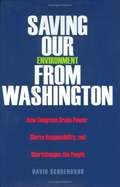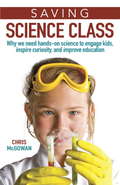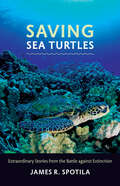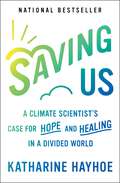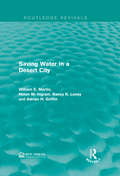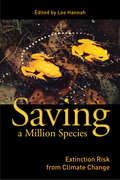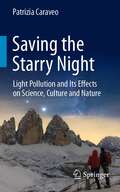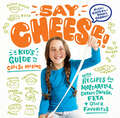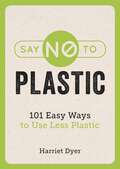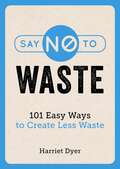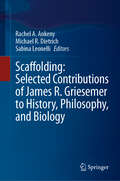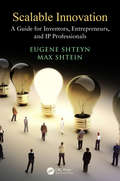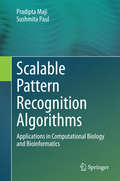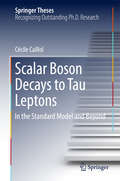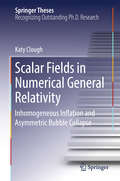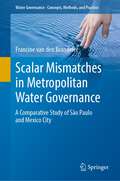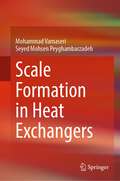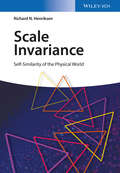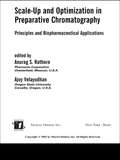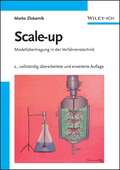- Table View
- List View
Saving Our Environment from Washington: How Congress Grabs Power, Shirks Responsibility, and Shortchanges the People
by David SchoenbrodCongress empowered the Environmental Protection Agency on the theory that only a national agency that is insulated from accountability to voters could produce the scientifically grounded pollution rules needed to save a careless public from its own filth. In this provocative book, David Schoenbrod explains how his experience as an environmental advocate brought him to this startling realization: letting EPA dictate to the nation is a mistake. Through a series of gripping and illuminating anecdotes from his own career, the author reveals the EPA to be an agency that, under Democrats and Republicans alike, delays good rules, imposes bad ones, and is so big, muscle-bound, and remote that it does unnecessary damage to our society. EPA stays in power, he says, because it enables elected legislators to evade responsibility by hiding behind appointed bureaucrats. The best environmental rules-those that have done the most good-have come when Congress had to take responsibility or from states and localities rather than the EPA. With the passion of an authentic environmentalist, Schoenbrod makes a sensible plea for "bottom-up" environmental protection now. The responsibility for pollution control belongs not in agencies but in legislatures, and usually not at the federal level but rather closer to home.
Saving Right Whales
by Barbara A. DonovanA mother right whale floats lazily on the surface of the water. Her calf swims close by and then rests by its mother with its tail across the mother's back.
Saving Science Class: Why We Need Hands-on Science to Engage Kids, Inspire Curiosity, and Improve Education
by Christopher McgowanMuch of what our students are learning about science in school bears little resemblance to real science. That is the main theme of this critique of science education by a veteran scientist and former school teacher. The author charges that today's teaching mandate has been taken over by educational specialists, people with little or no understanding of science. They clutter curricula with extraneous material, like engineering and technology, and focus so much attention theorizing over hypotheses and models and categorizing everything, that no time remains for doing science. There is little to entice youngsters to the science classroom today. McGowan emphasizes that the problem is not the teachers but the materials they are obliged to teach. He is especially critical of the widely influential "Next Generation Science Standards" (NGSS). This is based upon "A Framework for K-12 Science Education," which has been inordinately influenced by educational specialists. This is evident from the esoteric language, the almost exclusive citation of educational publications, and by glaring errors in science. The author urges a rethinking of science education to bring the focus back to conducting real hands-on science in the classroom. This approach was pioneered by the Nuffield Science Teaching Project in the UK, where working scientists acted as resource personnel for teachers designing curricula. Given the catastrophic problems facing planet Earth, scientific literacy has never been more important.From the Hardcover edition.
Saving Sea Turtles: Extraordinary Stories from the Battle against Extinction
by James R. SpotilaIn April 2007, eleven leatherback turtles captured the imagination of the public worldwide as they "raced" from Costa Rica toward the Galápagos Islands. Known as the Great Turtle Race, this event tracked these critically endangered sea turtles, drawing attention to their fragile status and generating data on the turtles vital to efforts to study and protect them.But the Great Turtle Race is just one of many tools marine conservationists use to inform people about the status, biology, and lives of the seven sea turtle species. Due to human actions, once-plentiful sea turtle population levels plummeted throughout much of the twentieth century, stabilizing somewhat only after Archie Carr and Jacques Cousteau popularized their plight. With Saving Sea Turtles, award-winning author James R. Spotila picks up where Carr and Cousteau left off, going inside the modern-day conservation movement to tell the tales of today’s sea turtle conservationists. He provides a complete overview of sea turtle biology and life cycles, discusses the human and natural world threats they face, and examines the new methods and technologies humans are using to save them. Throughout, Spotila dots the narrative with stories of real-life heroes who risk life and limb to understand, track, and conserve sea turtles across the globe.Spotila has been at the forefront of sea turtle research and conservation for decades. His inspirational story of dedicated individuals, creative endeavors, and adventure reveals what is being done and what else we must do in order to ensure that these fascinating animals continue swimming in the oceans.
Saving Us: A Climate Scientist's Case for Hope and Healing in a Divided World
by Katharine HayhoeUnited Nations Champion of the Earth, climate scientist, and evangelical Christian Katharine Hayhoe changes the debate on how we can save our future in this nationally bestselling &“optimistic view on why collective action is still possible—and how it can be realized&” (The New York Times).Called &“one of the nation&’s most effective communicators on climate change&” by The New York Times, Katharine Hayhoe knows how to navigate all sides of the conversation on our changing planet. A Canadian climate scientist living in Texas, she negotiates distrust of data, indifference to imminent threats, and resistance to proposed solutions with ease. Over the past fifteen years Hayhoe has found that the most important thing we can do to address climate change is talk about it—and she wants to teach you how. In Saving Us, Hayhoe argues that when it comes to changing hearts and minds, facts are only one part of the equation. We need to find shared values in order to connect our unique identities to collective action. This is not another doomsday narrative about a planet on fire. It is a multilayered look at science, faith, and human psychology, from an icon in her field—recently named chief scientist at The Nature Conservancy. Drawing on interdisciplinary research and personal stories, Hayhoe shows that small conversations can have astonishing results. Saving Us leaves us with the tools to open a dialogue with your loved ones about how we all can play a role in pushing forward for change.
Saving Water in a Desert City (Routledge Revivals)
by William E. Martin Helen M. Ingram Nancy K. Laney Adrian H. GriffinThis book was stimulated by and sets out to analyse a political battle over water pricing by a municipal system. Originally published in 1984, this title provides improved methods for demand function estimation where block rates are involved, suggests procedures for rational pricing of municipal water, and explains how politics can dominate when real decisions are made. Due to the additional virtue of this title being easy to read, it is ideal for students interested in environmental studies, economics, and policy making, as well as for those involved with municipal services and resource management in general.
Saving a Million Species: Extinction Risk from Climate Change
by Lee Hannah Thomas LovejoyThe research paper "Extinction Risk from Climate Change" published in the journal Nature in January 2004 created front-page headlines around the world. The notion that climate change could drive more than a million species to extinction captured both the popular imagination and the attention of policy-makers, and provoked an unprecedented round of scientific critique. Saving a Million Species reconsiders the central question of that paper: How many species may perish as a result of climate change and associated threats? Leaders from a range of disciplines synthesize the literature, refine the original estimates, and elaborate the conservation and policy implications. The book: examines the initial extinction risk estimates of the original paper, subsequent critiques, and the media and policy impact of this unique studypresents evidence of extinctions from climate change from different time frames in the pastexplores extinctions documented in the contemporary recordsets forth new risk estimates for future climate changeconsiders the conservation and policy implications of the estimates. Saving a Million Species offers a clear explanation of the science behind the headline-grabbing estimates for conservationists, researchers, teachers, students, and policy-makers. It is a critical resource for helping those working to conserve biodiversity take on the rapidly advancing and evolving global stressor of climate change-the most important issue in conservation biology today, and the one for which we are least prepared.
Saving the Earth as a Career
by Malcolm L. Hunter Jr. David B. Lindenmayer Aram J. CalhounWritten in an informal and engaging style, Saving the Earth as a Career is an ideal resource for students and professionals pursuing a career in conservation. The book explores the major skills needed to become an effective conservation professional by offering useful advice on a range of topics. Chapters include: Is this the right career for you? Designing a program of study Designing and executing a project Attending conferences and making presentations Writing papers Finding a job Making a difference Saving the Earth as a Career 2e is a friendly, accessible guide with a global perspective for anyone interested in becoming a conservation or environmental professional, and teachers will find this an invaluable resource for university students at all levels.
Saving the Starry Night: Light Pollution and Its Effects on Science, Culture and Nature
by Patrizia CaraveoThis book takes a close look at our relationship with the sky, the stars, light and darkness. In particular, it examines how light pollution has interfered with the culture of astronomy and our ability to appreciate this essential facet of our natural world. The sky has always held significance for humanity, in both cultural and scientific terms. And yet we persistently pollute it with (sometimes unnecessary) light in our obsessive desire to chase away the darkness. This effectively switches off the stars, hampering our ability to enjoy one of the most inspiring sights nature has to offer to humankind. In addition, too much light is hazardous to both our health and that of the fauna and flora of this planet. This book also features a comprehensive look at the current controversy regarding efforts to expand internet access through the launch into low Earth orbits of thousands of new satellites, which will pollute the night with moving lights while filling to saturation the capability of the circumterrestrial space. This conflict does not mean that the interests of astronomy and those of space technology have to be at odds, and potential compromises are explored between the satellite initiative and the desire to maintain a dark, radio silent sky.
Say Cheese!: A Kid's Guide to Cheese Making with Recipes for Mozzarella, Cream Cheese, Feta & Other Favorites
by Sarah Carroll Ricki CarrollBest-selling author Ricki Carroll — known around the world as “the Cheese Queen” — and her daughter, Sarah Carroll, bring easy cheese making right into your kitchen with this fun guide for kids and families. Step-by-step photos take kids ages 8–12 through the cheese making process, then teach them how to make 12 classic favorites, including mozzarella, feta, ricotta, and cream cheese. A hearty helping of kitchen chemistry and math along with bits of international cheese making history add to the education. A bonus log sheet lets young cheese makers keep notes just like the pros, while punch-out labels and colorful flags will embellish homemade cheeses and global cheese platters.
Say No to Plastic: 101 Easy Ways to Use Less Plastic
by Harriet DyerWe’ve reached an environmental crisis point with plastic, and it’s time to take action. But is it possible to make positive changes without radically changing your lifestyle? Absolutely! This practical book suggests eco-friendly alternatives to plastic, including budget options, high-street substitutes and DIY ideas to help you drastically reduce your plastic consumption. With 101 simple ways to use less plastic, you’ll find it easy to take the first step and make a difference.
Say No to Waste: 101 Easy Ways to Create Less Waste
by Harriet DyerThe world is overflowing with waste. It’s time to take action. You can make positive changes without radically altering your lifestyle. This practical book suggests ways to reduce waste, including how to cut unnecessary packaging, patch up or recycle old household items and drastically limit food waste. With 101 simple ways to create less waste, you’ll find it easy to take the first step and make a difference.
Scaffolding In Tissue Engineering
by Peter X. Ma Jennifer ElisseeffThe growing interest in scaffolding design and increasing research programs dedicated to regenerative medicine corroborate the need for Scaffolding in Tissue Engineering. While certain books and journal articles address various aspects in the field, this is the first current, comprehensive text focusing on scaffolding for tissue engineering.
Scaffolding: Selected Contributions of James R. Griesemer to History, Philosophy, and Biology
by Michael R. Dietrich Rachel A. Ankeny Sabina LeonelliThis book brings together some of Griesemer's most significant contributions for the first time, making it widely accessible in a single collection. Throughout his career James Griesemer has created an intellectual scaffold for major advances in the history and philosophy of biology. His analyses of boundary objects, units of selection, reproducers, models, and scaffolds have served and continue to serve as sites of innovation for philosophers, historians, and biologists. Griesemer’s oeuvre does not form a mere collection of important essays on disparate and disconnected topics. His works are best understood as units in a large philosophical puzzle, amounting to an overarching vision of how humans understand life and use that understanding for intervention, which in turn is grounded in a highly sophisticated historical and scientific understanding of the research practices in question. With edits, comments, and an in-depth introduction, this book is of great interest to historians and philosophers of biology as well as science in general.
Scalable Innovation: A Guide for Inventors, Entrepreneurs, and IP Professionals
by Eugene Shteyn Max ShteinInnovation is a primary source of economic growth, and yet only one idea out of 3,000 becomes a successful product or service. Scalable Innovation: A Guide for Inventors, Entrepreneurs, and IP Professionals introduces a model for the innovation process, helping innovators to understand the nature and timing of opportunities and risks on the path to
Scalable Pattern Recognition Algorithms
by Pradipta Maji Sushmita PaulThis book addresses the need for a unified framework describing how soft computing and machine learning techniques can be judiciously formulated and used in building efficient pattern recognition models. The text reviews both established and cutting-edge research, providing a careful balance of theory, algorithms, and applications, with a particular emphasis given to applications in computational biology and bioinformatics. Features: integrates different soft computing and machine learning methodologies with pattern recognition tasks; discusses in detail the integration of different techniques for handling uncertainties in decision-making and efficiently mining large biological datasets; presents a particular emphasis on real-life applications, such as microarray expression datasets and magnetic resonance images; includes numerous examples and experimental results to support the theoretical concepts described; concludes each chapter with directions for future research and a comprehensive bibliography.
Scalar Boson Decays to Tau Leptons: in the Standard Model and Beyond (Springer Theses)
by Cécile CaillolThis thesis presents a study of the scalar sector in the standard model (SM), as well as various searches for an extended scalar sector in theories beyond the SM (BSM). The first part of the thesis details the search for an SM Higgs boson decaying to taus, and produced by gluon fusion, vector boson fusion, or associated production with a vector boson, leading to evidence for decays of the Higgs boson to taus. In turn, the second part highlights several searches for an extended scalar sector, with scalar boson decays to taus. In all of the analyses presented, at least one scalar boson decays to a pair of taus. The results draw on data collected by the Compact Muon Solenoid (CMS) detector during proton–proton collisions with a center-of-mass energy of 7 or 8 TeV.
Scalar Fields in Numerical General Relativity: Inhomogeneous Inflation and Asymmetric Bubble Collapse (Springer Theses)
by Katy CloughThis book explores the use of numerical relativity (NR) methods to solve cosmological problems, and describes one of the first uses of NR to study inflationary physics. NR consists in the solution of Einstein’s Equation of general relativity, which governs the evolution of matter and energy on cosmological scales, and in systems where there are strong gravitational effects, such as around black holes. To date, NR has mainly been used for simulating binary black hole and neutron star mergers like those detected recently by LIGO. Its use as a tool in fundamental problems of gravity and cosmology is novel, but rapidly gaining interest. In this thesis, the author investigates the initial condition problem in early universe cosmology – whether an inflationary expansion period could have “got going” from initially inhomogeneous conditions – and identifies criteria for predicting the robustness of particular models. State-of-the-art numerical relativity tools are developed in order to address this question, which are now publicly available.
Scalar Mismatches in Metropolitan Water Governance: A Comparative Study of São Paulo and Mexico City (Water Governance - Concepts, Methods, and Practice)
by Francine van den BrandelerThe book provides insights into the particular nature of water-related challenges in metropolitan regions of the Global South and the “scalar mismatches” that prevent their sustainable and inclusive development. It argues for the adoption of a metropolitan water governance approach to assess these challenges, including the drivers and institutions that shape these, and the policy instruments at river basin and urban scales that aim to address these. The cases of Mexico City and São Paulo, as two mega-cities with a wide ranging of water-related challenges, present lessons to other fast growing urban agglomerations on the variety of possible responses as well as obstacles to their effectiveness that receive little attention.
Scale Formation in Heat Exchangers
by Mohammad Varnaseri Seyed Mohsen PeyghambarzadehThis book brings together a wide range of current research to create a holistic understanding of fouling. It draws upon practical and laboratory experiences spanning many years. While offering an overview of various fouling types, the book's emphasis is on crystallization fouling, a facet seldom addressed in the existing literature. Furthermore, this book goes beyond theory by providing practical examples for heat exchanger design, incorporating the pivotal consideration of fouling's impact. It focuses especially on calcium salts such as calcium carbonate and calcium sulfate.Fouling formation represents a ubiquitous challenge across diverse industrial sectors, spanning oil, gas, petrochemicals, food, pharmaceuticals, and power generation. This encroaching fouling, prevalent within heating equipment, not only jeopardizes the integrity of machinery but also significantly saps energy resources. Consequently, extensive research efforts have been undertaken to comprehensively explore fouling formation through both experimental and theoretical avenues across various heating apparatuses. The book's mission is to facilitate a broader comprehension of crystallization fouling research, revealing the various factors influencing this form of fouling. Additionally, it critiques prior research endeavors, identifying their strengths and weaknesses while pinpointing potential avenues for future investigation
Scale Invariance
by Dick HenriksenBringing the concepts of dimensional analysis, self-similarity, and fractal dimensions together in a logical and self-contained manner, this book reveals the close links between modern theoretical physics and applied mathematics. The author focuses on the classic applications of self-similar solutions within astrophysical systems, with some general theory of self-similar solutions, so as to provide a framework for researchers to apply the principles across all scientific disciplines. He discusses recent advances in theoretical techniques of scaling while presenting a uniform technique that encompasses these developments, as well as applications to almost any branch of quantitative science. The result is an invaluable reference for active scientists, featuring examples of dimensions and scaling in condensed matter physics, astrophysics, fluid mechanics, and general relativity, as well as in mathematics and engineering.
Scale Theory: A Nondisciplinary Inquiry
by Joshua DiCaglioA pioneering call for a new understanding of scale across the humanities How is it possible that you are—simultaneously—cells, atoms, a body, quarks, a component in an ecological network, a moment in the thermodynamic dispersal of the sun, and an element in the gravitational whirl of galaxies? In this way, we routinely transform reality into things already outside of direct human experience, things we hardly comprehend even as we speak of DNA, climate effects, toxic molecules, and viruses. How do we find ourselves with these disorienting layers of scale? Enter Scale Theory, which provides a foundational theory of scale that explains how scale works, the parameters of scalar thinking, and how scale refigures reality—that teaches us how to think in terms of scale, no matter where our interests may lie. Joshua DiCaglio takes us on a fascinating journey through six thought experiments that provide clarifying yet provocative definitions for scale and new ways of thinking about classic concepts ranging from unity to identity. Because our worldviews and philosophies are largely built on nonscalar experience, he then takes us slowly through the ways scale challenges and reconfigures objects, subjects, and relations. Scale Theory is, in a sense, nondisciplinary—weaving together a dizzying array of sciences (from nanoscience to ecology) with discussions from the humanities (from philosophy to rhetoric). In the process, a curious pattern emerges: attempts to face the significance of scale inevitably enter terrain closer to mysticism than science. Rather than dismiss this connection, DiCaglio examines the reasons for it, redefining mysticism in terms of scale and integrating contemplative philosophies into the discussion. The result is a powerful account of the implications and challenges of scale, attuned to the way scale transforms both reality and ourselves.
Scale-Sensitive Governance of the Environment
by Paul Opdam Nico Polman Frans Padt Catrien TermeerSensitivity to scales is one of the key challenges in environmental governance. Climate change, food production, energy supply, and natural resource management are examples of environmental challenges that stretch across scales and require action at multiple levels. Governance systems are typically ill-equipped for this task due to organisational and jurisdictional specialisation and short-term planning horizons. Further to this, scientific knowledge is fragmented along disciplinary lines and research traditions in academia and research institutions. State-of-the-art, Scale-Sensitive Governance of the Environment addresses these challenges by establishing the foundation for a new, trans-disciplinary research field. It brings together and reframes a variety of disciplinary approaches, using the idea of scales to create a conceptual and methodological basis for scale-sensitive governance of the environment from both a natural and social science perspective. This volume presents new visions, methods and innovative applications of thinking and decision making across scales in space and time to develop a holistic view on the subject. It is unique in providing: F analysis on how spatial, temporal, and governance scales are constructed, politically and scientifically defined, institutionalized in governance practices, and strategically used in policy discourses F details on how current environmental governance practices can be enriched by the use of theory on scale, with specific research themes to show the benefits of recognizing scales in empirical research F insightful case studies drawn from countries in the Americas, Eastern and Southern Africa, Europe, and South and Southeastern Asia, covering a wide range of environmental topics including biodiversity, climate change, commodities (tea and palm oil), cultural landscapes, energy, forestry, natural resource management, pesticides, urban development, and water management. With its comprehensive coverage of scale and scaling issues and convergence of widely different scientific approaches, this book is essential for environmental scientists, policy makers and planners, also conservation biologists and ecologists who are involved in modeling climate change impacts and sustainability. This reference will also benefit students of environmental studies, and all those who seek a response to the urgent environmental governance challenges for the decades ahead.
Scale-Up and Optimization in Preparative Chromatography: Principles and Biopharmaceutical Applications (Chromatographic Science Ser. #Vol. 88)
by Anurag S. RathorePresenting guidelines to predict and improve separation system performance, this book contains numerous case studies illustrating the practice of scale-up principles in process development. It offers solutions to limitations that occur in real-world purification schemes; methods to model, optimize, and characterize nonlinear separation processes; data comparisons from all stages of production; and industrial separation schemes for products such as synthetic molecules, antibody fragments, IgG, growth factors, and plasmid DNA. The book covers external constraints, separation economics, correlations for transport and kinetic phenomena, and the configuration and parameters of column design.
Scale-up: Modellübertragung in der Verfahrenstechnik
by Marko ZlokarnikDie Übertagung von Verfahren aus dem Labor-bzw. dem Techni-kumsmaßstab in den industriellen maßstab einer Produktiosanlage ist eine der wichtigsten ingenieurstechnischen Aufgaben in der chemischen Industrie. Die einzige zuverlässige Methode dazu basiert auf der Darstellung von Versuchsergebnissen im zutreffenden dimensions-analytischen Raum, der sich als maßstabsinvariant erweist. Das Buch ist in zwei Teile gegliedert: In der ersten Hälfte werden die vertiefte mathematische Vorkenntnisse dieses Themengebiet näherzubringen. Diskutiert werden die Grundlagen der Dimensionsanalyse, die Behandlung von temperaturabhängigen und von rheologischen Stoffwerten und die Modellübertragung bei Nichtverfügbarkeit von Modellstoffsystemen, sowie bei partieller Ähnlichkeit/ All dies wird dem leser anhand von 20 modernen Beispielen aus der heutigen verfahrenstechnischcen Praxis illustriert, der sich mit 25 in dieser Auflage neu hinzugekommenen Übungsaufgaben sein Verständnis aktive erarbeiten und anhand der Lösungen kontrollieren kann. Im zweitem Teil des Buches werden die einzelnen verfahrenstechnischen Grundoperationen aus den Bereichen mechanische, thermische und chemische Verfahrenstechnik aus der Sicht der Dimensionsanalyse und der Modellübertragung beispielhaft behandelt, und es werden für jede Operation die Maßstabsübertragungsregeln vorgestellt und diskutiert. Das vorliegende Buch wendet sich dementsprechend an Studenten wie auch bereits auf dem gebiet tätige Ingenieure, Chemiker und Verfahrenstechniker.
